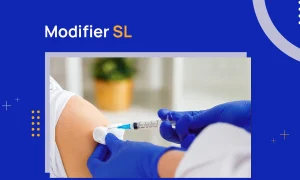The cardiovascular stress test is one of the most common tools in cardiology. It provides details about how your heart is performing under stress and whether you need immediate treatment.
However, medical billing in cardiology can get quite overwhelming, especially for stress tests. That’s because there are many similar codes, and a biller can get confused between them easily. Current Procedural Terminology (CPT) code 93017 is one such code that often raises questions. But it doesn’t have to.
To clarify all the confusion around CPT code 93017, our billing and coding experts have created this guide. In this blog, you will get all the information for this essential code and how to use it professionally.
So, let’s start.
93017 CPT Code Description
The CPT code 93017 is maintained by the American Medical Association (AMA) and used to bill an electrocardiography (ECG/EKG) procedure. Here’s the official definition:
“Cardiovascular stress test using a maximal or submaximal treadmill or bicycle exercise, continuous electrocardiographic monitoring, and/or pharmacological stress; tracing only, without interpretation and report.”
Sounds pretty hard, right? So, let’s break this down in simple terms.
If a technician hooks you up to the ECG and watches your heart while you are under stress, either due to exercise or induced with medicines, that’s CPT code 93017. It doesn’t include the doctor’s take on what the data means.
In other words, CPT code 93017 covers the technical component of a cardiovascular stress test. This includes:
- Setting up the equipment (e.g., treadmill, bicycle, or pharmacological agents).
- Attaching electrodes for continuous ECG monitoring.
- Recording the patient’s heart activity and vital signs during the test.
- Observing the patient during recovery until their heart rate stabilizes.
What it doesn’t include is the interpretation of the data or the written report. Those are billed separately under other CPT codes.
Appropriate Use Cases for CPT Code 93017
To make things clear, let’s look at a couple of examples where CPT code 93017 is applicable:
Pre-Surgical Clearance
A 60-year-old patient is scheduled for major surgery and has a history of hypertension. The surgeon requests a stress test to ensure the patient’s heart can handle the stress of the operation.
To do this, the patient undergoes a treadmill-based stress test. During the test, the lab technician records the ECG data. After the test is completed, the medical billers use the CPT code 93017 to bill for the technical component of the test.
Post-Heart Attack Evaluation
A 70-year-old patient recently suffered a mild heart attack. As part of the recovery plan, the cardiologist orders a stress test to assess the heart’s current function.
However, since the surgery was performed recently, the stress is induced with the help of some drugs instead of exercise. The technician monitors and records the heart’s activity. The biller then files a claim with CPT 93017 since only the test was performed, and the doctor didn’t interpret the results.
Modifiers to Append with CPT Code 93017
Since code 93017 is a specific and self-explanatory CPT code, there aren’t many modifiers that you can use with it. An important thing to note here is that the 93017 already indicates the technical component of the procedure. So, you don’t have to add the modifier TC separately.
Modifier 59
Use modifier 59 when the stress test is performed separately from other services on the same day. For instance, if a patient has a stress test and an unrelated EKG during the same visit, modifier 59 shows they’re distinct, preventing bundling issues.
Modifier XE
The modifiers XE and 59 are similar but slightly different, so don’t get confused.
The XE specifies that the stress test occurred during a separate encounter on the same day. For example, if a patient has a morning stress test and an afternoon procedure, modifier XE clarifies the timing.
In most cases, Medicare gives priority to XE over modifier 59. So, if possible, use the former while filing claims with code 93017.
Reimbursement Guidelines for CPT Code 93017
Now that you understand what 93017 is and how it works, here are some guidelines that can help you prevent denials and delayed reimbursements:
Prove Medical Necessity
It’s common sense that the insurance companies won’t pay for the test without a clear reason. So, we emphasize attaching all the relevant medical documents with your claim that justify the test.
Plus, document the patient’s symptoms (e.g., chest pain, fatigue) or risk factors (e.g., diabetes, high cholesterol). Also, if during the test, drugs were used to induce stress, please provide an explanation of why exercise wasn’t an option.
Use Component Coding Properly
Stress tests are often split into components:
- CPT 93016: Physician supervision.
- CPT 93017: Technical component (tracing).
- CPT 93018: Interpretation and report.
Only bill CPT code 93017 for the technical part. If your team also interprets the results, submit CPT code 93018 separately.
Track Referrals
If, for instance, another doctor ordered the test, include the referral details of that doctor. This can include things like date, referring physician, and purpose. This supports the claim’s validity.
Avoid Common Pitfalls
You should also try to avoid the common mistakes made by the billers. The following are some:
- Skip Redundant Modifiers: Don’t use Modifier TC or 26 with CPT code 93017.
- Justify the Test: Claims without a clinical reason will be denied.
- Clarify Roles: Specify who performed the technical work to avoid overlap with other codes.
Final Thoughts on CPT Code 91200
The cardiovascular stress test and CPT code 93017 might seem complex, but they don’t have to be. With this guide, we believe you have all the necessary information to use code 93017 correctly.
However, billing and coding aren’t for everyone. It is a complex process and requires expert supervision. To increase your reimbursement rates and decrease denials, try our professional cardiology billing services.



